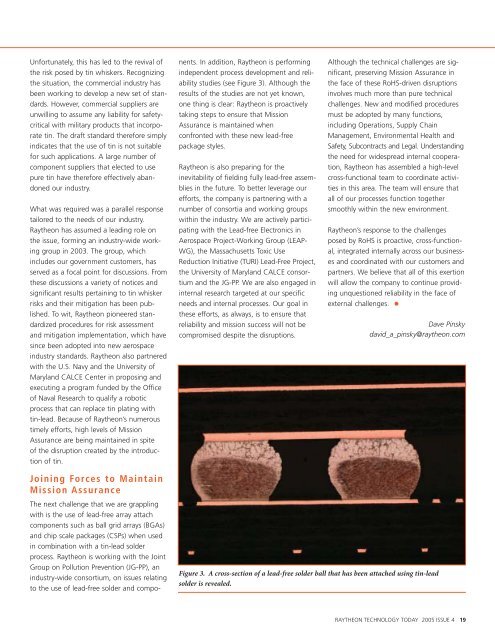technology today 2005 issue 4 - Raytheon
technology today 2005 issue 4 - Raytheon
technology today 2005 issue 4 - Raytheon
You also want an ePaper? Increase the reach of your titles
YUMPU automatically turns print PDFs into web optimized ePapers that Google loves.
Unfortunately, this has led to the revival of<br />
the risk posed by tin whiskers. Recognizing<br />
the situation, the commercial industry has<br />
been working to develop a new set of standards.<br />
However, commercial suppliers are<br />
unwilling to assume any liability for safetycritical<br />
with military products that incorporate<br />
tin. The draft standard therefore simply<br />
indicates that the use of tin is not suitable<br />
for such applications. A large number of<br />
component suppliers that elected to use<br />
pure tin have therefore effectively abandoned<br />
our industry.<br />
What was required was a parallel response<br />
tailored to the needs of our industry.<br />
<strong>Raytheon</strong> has assumed a leading role on<br />
the <strong>issue</strong>, forming an industry-wide working<br />
group in 2003. The group, which<br />
includes our government customers, has<br />
served as a focal point for discussions. From<br />
these discussions a variety of notices and<br />
significant results pertaining to tin whisker<br />
risks and their mitigation has been published.<br />
To wit, <strong>Raytheon</strong> pioneered standardized<br />
procedures for risk assessment<br />
and mitigation implementation, which have<br />
since been adopted into new aerospace<br />
industry standards. <strong>Raytheon</strong> also partnered<br />
with the U.S. Navy and the University of<br />
Maryland CALCE Center in proposing and<br />
executing a program funded by the Office<br />
of Naval Research to qualify a robotic<br />
process that can replace tin plating with<br />
tin-lead. Because of <strong>Raytheon</strong>’s numerous<br />
timely efforts, high levels of Mission<br />
Assurance are being maintained in spite<br />
of the disruption created by the introduction<br />
of tin.<br />
Joining Forces to Maintain<br />
Mission Assurance<br />
The next challenge that we are grappling<br />
with is the use of lead-free array attach<br />
components such as ball grid arrays (BGAs)<br />
and chip scale packages (CSPs) when used<br />
in combination with a tin-lead solder<br />
process. <strong>Raytheon</strong> is working with the Joint<br />
Group on Pollution Prevention (JG-PP), an<br />
industry-wide consortium, on <strong>issue</strong>s relating<br />
to the use of lead-free solder and compo-<br />
nents. In addition, <strong>Raytheon</strong> is performing<br />
independent process development and reliability<br />
studies (see Figure 3). Although the<br />
results of the studies are not yet known,<br />
one thing is clear: <strong>Raytheon</strong> is proactively<br />
taking steps to ensure that Mission<br />
Assurance is maintained when<br />
confronted with these new lead-free<br />
package styles.<br />
<strong>Raytheon</strong> is also preparing for the<br />
inevitability of fielding fully lead-free assemblies<br />
in the future. To better leverage our<br />
efforts, the company is partnering with a<br />
number of consortia and working groups<br />
within the industry. We are actively participating<br />
with the Lead-free Electronics in<br />
Aerospace Project-Working Group (LEAP-<br />
WG), the Massachusetts Toxic Use<br />
Reduction Initiative (TURI) Lead-Free Project,<br />
the University of Maryland CALCE consortium<br />
and the JG-PP. We are also engaged in<br />
internal research targeted at our specific<br />
needs and internal processes. Our goal in<br />
these efforts, as always, is to ensure that<br />
reliability and mission success will not be<br />
compromised despite the disruptions.<br />
Although the technical challenges are significant,<br />
preserving Mission Assurance in<br />
the face of these RoHS-driven disruptions<br />
involves much more than pure technical<br />
challenges. New and modified procedures<br />
must be adopted by many functions,<br />
including Operations, Supply Chain<br />
Management, Environmental Health and<br />
Safety, Subcontracts and Legal. Understanding<br />
the need for widespread internal cooperation,<br />
<strong>Raytheon</strong> has assembled a high-level<br />
cross-functional team to coordinate activities<br />
in this area. The team will ensure that<br />
all of our processes function together<br />
smoothly within the new environment.<br />
<strong>Raytheon</strong>’s response to the challenges<br />
posed by RoHS is proactive, cross-functional,<br />
integrated internally across our businesses<br />
and coordinated with our customers and<br />
partners. We believe that all of this exertion<br />
will allow the company to continue providing<br />
unquestioned reliability in the face of<br />
external challenges.<br />
Dave Pinsky<br />
david_a_pinsky@raytheon.com<br />
Figure 3. A cross-section of a lead-free solder ball that has been attached using tin-lead<br />
solder is revealed.<br />
RAYTHEON TECHNOLOGY TODAY <strong>2005</strong> ISSUE 4 19

















